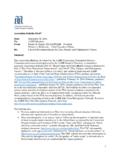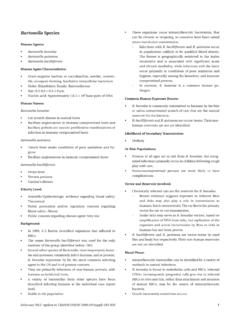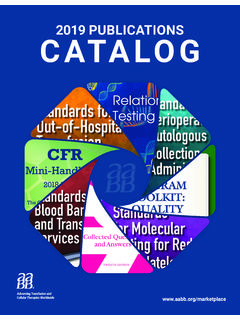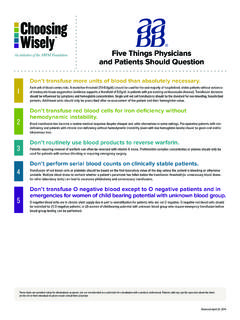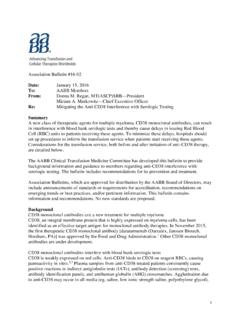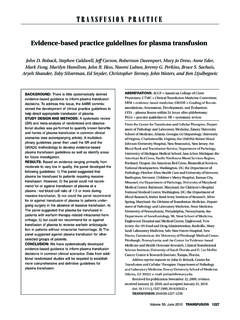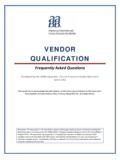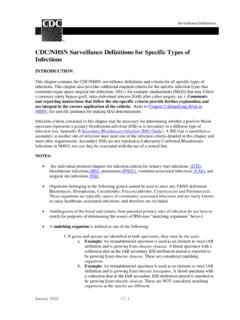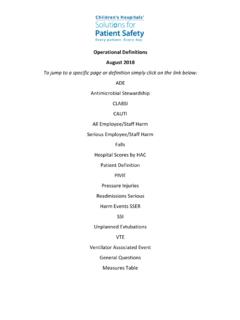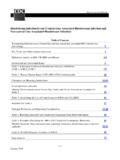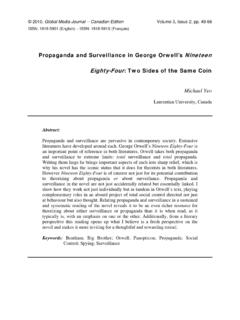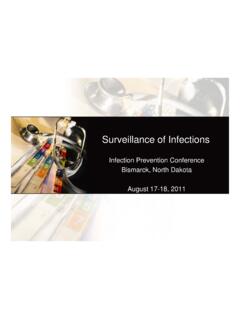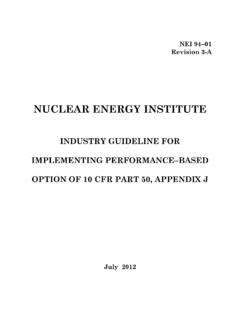Transcription of Standard for Surveillance of Complications Related to ...
1 ISBT/IHN 2014 definitions Complications Related to blood donation 1 Standard for Surveillance of Complications Related to Blood Donation Working Group on Donor Vigilance of the International Society of Blood Transfusion Working Party on Haemovigilance in collaboration with The International Haemovigilance Network The AABB Donor Haemovigilance Working Group December 11, 2014 These definitions have been formally endorsed by The Alliance of Blood Operators The European Blood Alliance ISBT/IHN 2014 definitions Complications Related to blood donation 2 Introduction to the 2014 revised classification Complications Related to blood donations are adverse reactions and events with a temporal relation to a blood donation. Longer term Complications associated with donation, such as iron deficiency, are not all captured in this donor vigilance scheme.
2 The 2008 ISBT Standard for Surveillance of Complications Related to blood donation introduced a classification with descriptions of types of Complications . Two problems were noted with the definitions: 1. Descriptions were not sufficiently specific to permit Standard classification and comparison of different donor Surveillance programs. 2. Definitions were difficult to apply because they required information not easily obtainable in many countries. A revision group was convened in 2013 to review the 2008 definitions and propose modifications. The goals of this revised classification system are: 1. Provide simple definitions that are easy to apply in a standardised way. 2. Provide minimal requirements for international comparison that meet the needs of a basic Surveillance program. 3. Provide additional attributes that may be collected nationally if possible.
3 This additional information may be important for process improvement by the blood centre, or lead to relevant research in donor reactions. Comparisons may be made internationally by those blood centres that are able to collect this information. 4. Align definitions with those used in the AABB Donor Hemovigilance System, to permit comparisons and entry of data into an adapted version of the donorHART software. The revisions to the 2008 document have been made with these goals in mind. The revision subcommittee Mindy Goldman, chair Kevin Land Pierre Robillard Peter Tomasulo Jo Wiersum-Osselton ISBT/IHN 2014 definitions Complications Related to blood donation 3 Table of Contents Definitions of adverse Grading of complication severity and Appendix 1 Summary table, Complications of Appendix 2 Recommended numerator and denominator data and basic information to ISBT/IHN 2014 definitions Complications Related to blood donation 4 Definitions of adverse events A.
4 Complications mainly with local symptoms These Complications are directly caused by the insertion of the needle. Some of these are mainly characterized by occurrence of blood outside vessels, whereas others are mainly characterized by pain. A 1. Complications mainly characterized by the occurrence of blood outside the vessels. Haematoma (bruise) definition : A haematoma is an accumulation of blood in the tissues outside the vessels. Mechanism: The symptoms are caused by blood flowing out of damaged vessels and accumulating in the soft tissues. For apheresis procedures, haematomas may also be caused by infiltration of the soft tissues by red cells during the return phase of the procedure. Large haematomas, particularly those in deeper layers of the forearm, put pressure on surrounding tissues and may contribute to other Complications such as nerve irritation and injury and more rarely compartment syndrome.
5 Signs and symptoms: Bruising, discolouration, swelling and local pain. Accumulation of blood in deeper tissues may result in more serious pain and pressure syndromes listed below. Arterial puncture definition : Arterial puncture is a puncture of the brachial artery or of one of its branches by the needle used for bleeding the donor. Mechanism: Because of the rapid blood flow, the risk of a large haematoma is increased and thereby risks of more serious pain and pressure syndromes listed below. Signs and symptoms: A lighter red colour than usual of the collected blood can be seen. The needle and tubing may appear to pulsate; the blood bag fills very quickly. There may be weak pain localized to the elbow region. Delayed bleeding (re-bleeding) - optional category definition : Leakage of blood from the venipuncture site after the initial bleeding has stopped.
6 Mechanism: Re-bleeding may be Related to pressure not being applied to the correct location or for an adequate duration, or premature removal of the bandage. After the donor has left the clinic, re-bleeding may be Related to heavy lifting or strain to the donor s arm. Donors on certain medications, such as autologous donors on anticoagulants, may be at higher risk to re-bleed. Signs and symptoms: Spontaneous recommencement of bleeding from the venipuncture site, after pressure has been applied and the initial dressing has been removed, or leaking through the dressing. ISBT/IHN 2014 definitions Complications Related to blood donation 5 A 2. Complications mainly characterized by pain Nerve injury/irritation definition : Injury or irritation of a nerve Mechanism: A nerve may be hit directly by the needle at insertion or withdrawal, or there may be pressure on a nerve due to a haematoma or inflammation of the soft tissues.
7 Include medically diagnosed cases, as well as cases reported on the basis of documented nerve type symptoms. Signs and symptoms: Radiating, often electrical sharp pain moving away from the venepuncture site, and/or paraesthesias such as tingling, burning sensations in the hand, wrist or shoulder area but away from the venepuncture site. Symptoms may arise immediately when the needle is inserted or withdrawn. In cases associated with a haematoma, pain may not be apparent at the time and may start when the haematoma has reached a sufficient size, some time after insertion of the needle. Symptoms may be worse in certain positions or with certain arm motions. Rarely, weakness of the arm may develop. Optional split by duration of symptoms: Symptoms resolving within 12 months: Symptoms usually resolve within days, but rarely may persist for months or become permanent.
8 Symptoms lasting more than 12 months. Other Painful arm optional category definition : Pain in the arm is the primary symptom, without the characteristics of nerve irritation outlined above, or the presence of a large hematoma or other defined Complications that may be Mechanism: Pain may be Related to tissue injury, possibly due to hematoma in the deeper tissues. Signs and symptoms: Pain in the arm, without characteristics of nerve irritation. May be described as an ache or heaviness in the arm, similar to that experienced after vaccination. Include all cases where arm pain is the main symptom, unless a diagnosis of nerve injury/irritation is suspected in the presence of nerve type symptoms recognised by trained staff. A 3. Localised infection/inflammation Localised infection/inflammation definition : Inflammation along the course of a vein, which may progress to localised infection several days after phlebotomy.
9 There may be clotting in the vein. Mechanism: Tissue damage and introduction of surface bacteria into the deeper tissues with venepuncture. The superficial vein itself (thrombophlebitis) or the surrounding subcutaneous tissue (cellulitis) may be predominantly affected. Signs and symptoms: Warmth, tenderness, local pain, redness and swelling at the site of phlebotomy. The site and the vein may feel tender, firm, and warm to the touch. Fever may be present. Optional split into 2 categories: ISBT/IHN 2014 definitions Complications Related to blood donation 6 Thrombophlebitis: The redness, swelling, and tenderness extend along the course of the vein. Cellulitis: The redness, swelling and tenderness affect the soft tissues, and are not localised to the course of the vein. A 4. Other major blood vessel injury These rare, serious conditions must always be medically diagnosed.
10 Deep venous thrombosis (DVT) definition : Thrombosis of a deep vein in the donor s phlebotomy arm. Mechanism: Superficial venous thrombosis may progress into the deeper veins of the donor s arm. DVT may also rarely occur without previous signs and symptoms of superficial thrombosis. An additional risk factor for thrombosis, in particular, the use of oral contraceptives, may be present in these donors. Symptoms and signs: Swelling and pain in the upper arm. May be accompanied by symptoms of superficial inflammation and thrombosis (see above). Arteriovenous fistula definition : Acquired connection between the vein and artery due to venepuncture lacerations. Mechanism: A channel forms between the lacerated vein and artery immediately post-venepuncture, or in the healing process. May be Related to arterial puncture.

